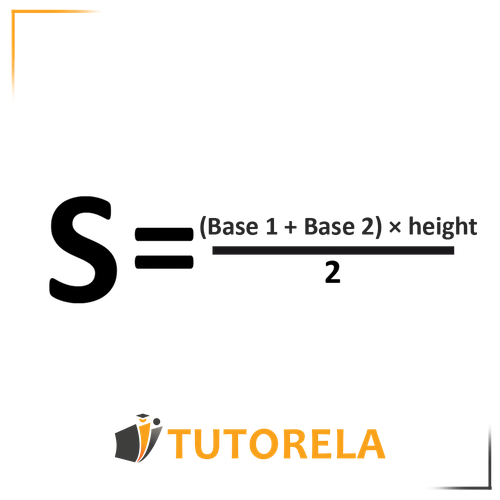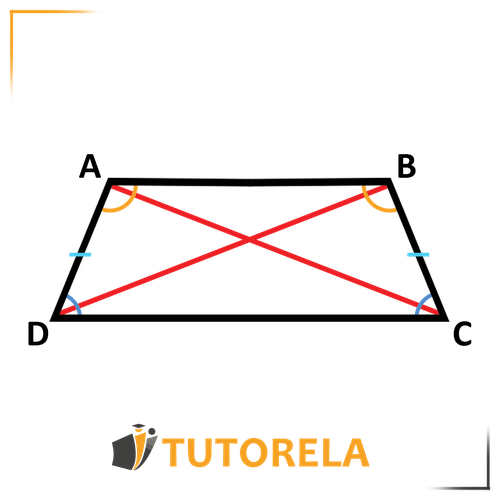How to calculate the area of an isosceles trapezoid?
Area of an isosceles trapezoid
Area of an isosceles trapezoid
In order to calculate the area of an isosceles trapezoid, like every trapezoid's area, we need to multiply the height by the sum of the bases and divide by .
That is:

Important point – The midsegment of a trapezoid equals half the sum of the bases
Test yourself on area of a trapezoid!

Calculate the area of the trapezoid.
Area of an isosceles trapezoid
Properties of an isosceles trapezoid:
- In an isosceles trapezoid, the 2 legs are equal.
- In an isosceles trapezoid, the base angles are equal.
- In an isosceles trapezoid, the diagonals are equal.

Important point - The midsegment of a trapezoid equals half the sum of the bases.
Reminder - A midsegment is a straight line that extends from the middle of one leg of a trapezoid to the middle of the other leg.
How to calculate the area of an isosceles trapezoid?
In order to calculate the area of an isosceles trapezoid, we need to multiply the height by the sum of the bases and divide by 2.
Therefore:

It often comes in handy to remember that mid-segment in a trapezoid equals half the sum of the bases.
Now what? Let's move on to practice.
Don't worry, we'll start with simple exercises and continue to more advanced ones.
Exercise:
Given an isosceles trapezoid

Given that:
and also height to trapezoid
What is the area of the trapezoid?
Solution:
In order to calculate the area of the trapezoid, we first need to add the bases, multiply by the height, and then divide by .
According to the given data, the upper base , and the lower base
We get:
The area of the trapezoid is cm².
Another exercise:
Here is an isosceles trapezoid

Given that:
Angle
What is the area of the trapezoid?
Solution
We know that in order to calculate the area of a trapezoid, we need to know the sum of the two bases and the height.
The two bases are given to us and their sum is .
Now all we need to do is to determine the height.
Let's note that angle . This indicates that segment is the height of the trapezoid.
We are also given that , thus if we find we will discover the height
We know that and that
Therefore must equal because the whole is equal to the sum of its parts.
So the height equals .
The area of the trapezoid is:
square cm.
Additional Exercise:
Here is a trapezoid.

Calculate the area of the trapezoid given that:
angle
Solution:
In order to calculate the area of the trapezoid, we need to determine what is the sum of the bases and what is the height.
We are given that angle which means that is the height of the trapezoid.
According to the given data .
We now need to understand what is the sum of the bases.
Note - we are given that:
This means that the trapezoid is an isosceles trapezoid and segment divides the legs exactly in the middle. Only in this way can a situation arise where all halves are equal.
Therefore, we can determine that is a midsegment in the trapezoid - a line extending from the middle of one leg to the middle of the other leg.
We know that a midsegment in a trapezoid equals half the sum of the bases.
According to the given data which means that the sum of the bases is .
Now all that remains to do is to substitute into the trapezoid area formula and determine the area of the trapezoid:
The area of the trapezoid is cm².
Another exercise:

Given an isosceles trapezoid.
Given that the area of the trapezoid is cm².
Find the height of the trapezoid
We know that is the midsegment of the trapezoid and equals .
Solution:
We know that in a trapezoid, the midsegment equals half the sum of the bases, so the sum of the bases is .
Let's substitute the given data into the formula and we should obtain the following:
The height of the trapezoid is .
Calculate the area of the trapezoid.
Calculate the area of the trapezoid.
Given the following trapezoid:
Calculate the area of the trapezoid ABCD.
Examples with solutions for Area of a Trapezoid
Exercise #1
Calculate the area of the trapezoid.
Video Solution
Step-by-Step Solution
We use the formula (base+base) multiplied by the height and divided by 2.
Note that we are only provided with one base and it is not possible to determine the size of the other base.
Therefore, the area cannot be calculated.
Answer
Cannot be calculated.
Exercise #2
Given the trapezoid:
What is the area?
Video Solution
Step-by-Step Solution
Formula for the area of a trapezoid:
We substitute the data into the formula and solve:
Answer
52.5
Exercise #3
The trapezoid ABCD is shown below.
AB = 2.5 cm
DC = 4 cm
Height (h) = 6 cm
Calculate the area of the trapezoid.
Video Solution
Step-by-Step Solution
First, let's remind ourselves of the formula for the area of a trapezoid:
We substitute the given values into the formula:
(2.5+4)*6 =
6.5*6=
39/2 =
19.5
Answer
Exercise #4
The trapezoid ABCD is shown below.
Base AB = 6 cm
Base DC = 10 cm
Height (h) = 5 cm
Calculate the area of the trapezoid.
Video Solution
Step-by-Step Solution
First, we need to remind ourselves of how to work out the area of a trapezoid:
Now let's substitute the given data into the formula:
(10+6)*5 =
2
Let's start with the upper part of the equation:
16*5 = 80
80/2 = 40
Answer
40 cm²
Exercise #5
What is the area of the trapezoid in the figure?
Video Solution
Step-by-Step Solution
We use the following formula to calculate the area of a trapezoid: (base+base) multiplied by the height divided by 2:
Answer
cm².
More Questions
Area of a Trapezoid
- Calculate Trapezoid Area: Finding Space Between 5 and 7 Unit Bases
- Trapezoid Problem: Find Side AB Given Area 126 and Height 9
- Solve for X: Trapezoid Area of 12 cm² with Triangle Relationship
- Calculate Trapezoid Height: Given Area 30 and Parallel Sides 6 and 9
- Calculate the Area of an Equilateral Hexagon with Side Length 7 and Height 12.124
- Area
- Trapezoids
- Symmetry in Trapezoids
- Diagonals of an isosceles trapezoid
- Perimeter of a trapezoid
- Types of Trapezoids
- Isosceles Trapezoid
- Parallelogram
- The area of a parallelogram: what is it and how is it calculated?
- Perimeter of a Parallelogram
- Kite
- Area of a Deltoid (Kite)
- Rectangle
- Calculating the Area of a Rectangle
- The perimeter of the rectangle
- Midsegment
- Midsegment of a trapezoid
- Rhombus, kite, or diamond?
- The Area of a Rhombus
- Perimeter
- Triangle
- The Area of a Triangle
- Area of a right triangle
- Area of Isosceles Triangles
- Area of a Scalene Triangle
- Area of Equilateral Triangles
- Perimeter of a triangle
- Areas of Polygons for 7th Grade
- How do we calculate the area of complex shapes?
- How to calculate the area of a triangle using trigonometry?
- How do we calculate the perimeter of polygons?









